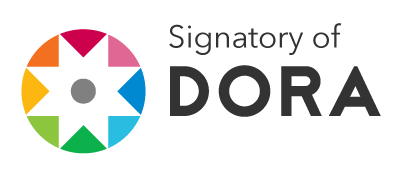Enología y Oferta Floral de Trébol Rojo Trifolium pratense (Fabales: Fabaceae) en Praderas de Kikuyo Penissetum clandestinum (Poales: Poaceae), como Fuente Alimento para Bombus atratus (Hymnoptera, Apoidea) en Cajicá, Colombia
Resumen
Durante 14 meses se evaluó el desarrollo del trébol rojo (Trifolium pratense) sembrado a partir de semillas en una parcela de kikuyo (Penissetum clandestinum) de 100 m2 recientemente podado en Cajicá (Cundinamarca, Colombia). Se tomaron informaciones sobre porcentaje de cobertura, oferta floral y fenología floral. Estas variables fueron relacionadas con datos climáticos mensuales de temperatura máxima y mínima del aire, promedio de humedad relativa y precipitación mensual total. La relación entre la oferta floral y los eventos climáticos es descrita. Se hacen comentarios sobre la importancia de la precipitación en la fenología del trébol y se muestran datos fenológicos mensuales que son fundamentales para entender la contribución de T. pratense al establecimiento de especies polinizadoras como Bombus atratus.Descargas
Lenguajes:
ESReferencias bibliográficas
Aldana J., Cure J. R., Almanza M. T., Vecil D., Rodríguez D. 2007. Effect of Bombus atratus (Hymenoptera:Apidae) on tomato production (Lycopersicon esculentum Mill.) in greenhouse in Bogotá plateau, Colombia. Agronomía Colombiana 25(1):62-72.
Almanza M. T. 2007. Breeding domestic bumblebees (Bombus atratus), and their use to in pollination Lulo crops (Solanum quitoense L.), a local fruit of the Colombian Andes region. Institute of Crop Science and Resources Protection, Faculty of Agriculture, University of Bonn. (1): 13- 35.
Barrow, D. A y Pickard R. S. 1984. Size-related Selection of Food Plants by Bumblebees. Ecologycal Entomology (9):369–373.
BIissuel-Belaygue C., Cowan A. A., Marshal A. H. y Wery J. 2002. Reproductive Development of White clover (Trifolium repens L.) is not impaired by moderate Water Deficit that Reduces Vegetative Growth: II Fertilization Efficiency and seed set. Crop Science. (42):414-422.
Bohart G. 1957. Pollination of Alfalfa and Red Clover. Annual Review of Entomology (2):355-380.
Borchert R., Meyer S., Felger R. y Porter-Bolland L. 2004. Environmental Control of Flowering Periodicity in Costa Rican and Mexican Tropical dry Forest. Global Ecology and Biogeography,(13):409–425.
Bradbear N. 2009. Non Wood forest Products 19. Bees and Their Role in Forest Livehoods. A Guide to Services Provided by Bees and the Sustainable Harvesting Processing and Marketing of their Products. FAO. 13 -16.
Brown B. y Scott R. R. 1992. An Assessment of Vicia faba and Trifolium pratense as Forage Crops for Bombus hortorum. New Zealand Entomologist (15): 41 -46.
Carvell C. 2002. Habitat use and conservation of bumblebees (Bombus spp.) under different grassland management regimes. Biological Conservation (103):33–49.
Carvell C., Meek W. R., Pywell F., Goulson D. y Nowakowski M. 2007. Comparing the efficacy of agro-environment schemes to enhance bumble bee abundance and diversity on arable field margins. Journal of Applied Ecology. (44): 29–40.
Correa H. 2006. Perfil de Mercado de Semillas forrajeras – Colombia., “Monitoreo nutricional y metabólico en hatos lecheros”, Universidad Nacional de Colombia, Departamento de Producción Animal.(1). 89 – 95.
Cruz, O. 2000. Determinación de las diferencias en las dietas de tres especies de abejorros del género Bombus en sus ambientes naturales mediante el análisis palinológico. Trabajo de Grado. Universidad Militar Nueva Ganada.23 – 47.
Cruz P., Almanza M. T. y Cure J. R. 2007. Logros y perspectivas de la cría de abejorros del género Bombus en Colombia. Revista Facultad de Ciencias Básicas. Universidad Militar Nueva Granada (3):49 – 60.
Damgaard C., Simonsen V. y Osborne J. 2007. Prediction of Pollen-Mediated Gene Flow Between Fields of Red Clover (Trifolium pratense). Environ Model Assess (4): 9112-9118.
Donovan B. J. 1993. History and utilization of imported bumblebees in New Zealand. Honey bee science. (4) 145 – 152.
Free J. B. 1965. The Ability of Bumblebee and Honeybees to Pollinate Red Clover. Journal of Applicated Ecology (2):289-294.
Hayo H.W., Velthius y Van Doorn A. 2004. The Breeding, Commercialization and Economic Value of Bumblebees. En: B. M. Freitas y J. O. Pereira. Solitary Bees, Conservation, Rearing and Management for Pollination. Federal university of Ceara. Brasil Ed Fortaleza CE. 16 - 55.
Hayo, H.W., Velthius y Van Doorn, A. 2006. A Century Of Advances in Bumblebee Domestication and the Economic and Environmental Aspects of its Commercialization for Pollination. Apidologie (37):421– 451.
Hernández-G, M., Rosales-C, N., Cortés S., S.P 2011. Riqueza y Diversidad Florística de un Bosque de Niebla Subandino en la Reserva Forestal Laguna de Pedro Palo (Tena – Cundinamarca, Colombia). Revista Facultad de Ciencias Básicas, 7:32 – 47.
Holm S. 1966. The Utilization And Management Of Bumble Bees For Red Clover And Alfalfa Seed Production. Annual Review of Entomology (11):155-182.
Hopkins I. 1914. History of Bumblebees in New Zealand: its Introductions and Results. N. Z. Department of Agricultural Industries and Commercialization (46):1-29.
Jeanneret F. y Rutishauser T. 2010. Seasonality as a Core Business in Phenology. En Keatly M. y Hudson I. (Eds.) 2010. Phenological Research. Methods for Enviromental and Climate Reseacrh Analysis. Springer. 63 – 75.
Koch E. 2010. Phenological Research. Methods for Enviromental and Climate Reseacrh Analysis. Global Framework for Data Collection, Data Bases, Data Availability, future Networks, Online databases.Springer. London. 23 – 63.
Kricher, J. C. y Davis, W. E. 1997 A Neotropical Companion: An Introduction To The Animals, Plants, And Ecosystems Of The New World Tropics. Princeton University Press. pp 20 - 65.
McGregor, S. E. 1976. Red Clover. En.. Insect Pollination of Cultivated Crop plants. USDA. 96 - 183.
Morellato P., Camargo M., D’eça Neves F., Luize B., Mantovani A. y Hudson I. 2010. The Influence of Sampling Method, sample size, and Frequency of Observations on Plant Phenologycal Patterns and Interpretation on Tropical Forest Trees. En Keatly M. y Hudson I. (Eds.) 2010. Phenological Research. Methods for Enviromental and Climate Reseacrh Analysis. Springer. London. 99 - 123.
Opler P., Frankie G. y Baker H. 1976. Rainfall as a Factor in the Release, Timing, and Synchronization of Anthesis by Tropical Trees and Shrubs. Journal of Biogeography. (3): 231-236.
Pedraza Luengas, A., Pérez Trujillo, M.M., Cortés Zambrano I.C., Arias Gómez L.C. 2011. Evaluación de un Biofermento de Preparación Local para el Abonamiento Orgánico del Tomillo (Thymus vulgaris), Romero (Rosmarinus officinalis) y Orégano (Origanum vulgare). Revista Facultad de Ciencias Básicas, 7:10-31.
Rebolledo R., Martínez H., Palma M., Aguilera P. y Klein K. 2004. Actividad de visita de Bombus dahlbomi (Guérin) y Bombus ruderatus (F.) (Hymenoptera:Apidae) sobre Trébol Rosado (Trifolium pratense L.) en la IX Región de La Araucanía, Chile. Universidad de La Frontera, Facultad de Ciencias Agropecuarias y Forestales. Agricultura Técnica. 31 – 35.
Shuel, R. W. 1951. Some Factors Affecting nectar Secretion In Red Clover. Department of Botany and Plant Pathology. The Ohio State University. Apiculture Department, Ontario Agricultural College, Guelph, Canada. Columbus 10, Ohio, 539.
Sturz, A.V., Christie B.R., Matheson B.G. y Nowak J. 1997. Biodiversity of endophytic bacteria which colonize red clover nodules, roots, stems and foliage and their influence on host growth. Biology of Fertilization of Soils. (25):13–19.
Urbina-Cardona, J.N. 2011. Gradientes Andinos en la Diversidad y Patrones de Endemismo en Anfibios y Reptiles de Colombia: Posibles Respuestas al Cambio Climatico. Revista Facultad de Ciencias Básicas, 7:74 - 91.












